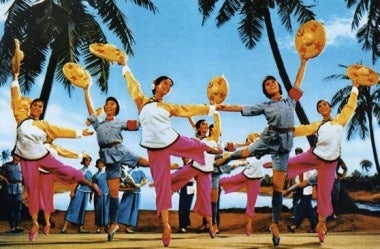Island's Tour Operators Offering Stripped-Down Packages Promoting Hainan's Role In Establishment Of PRC#

Last year, the Chinese government announced controversial plans to transform Hainan island -- China's southernmost province -- into an international tourist destination, on par with popular spots like Hawaii, Thailand and Australia. This transformation, which is designed to give the island a five-star makeover, adding new golf courses, luxury hotels, and world-class service and transportation standards, has already had an effect on Hainan, though not everyone agrees the immediate effects have all been positive.
The government's plan to create a tropical paradise in Hainan has brought a flood of speculative money into the market, causing many commentators in China and abroad to worry that a property bubble akin to the one that formed (and popped) in the 1990s -- causing years of stagnation in the island's economy -- could be inflating right in front of our eyes. This, added to political tensions caused by Vietnam's unease at China's Hainan development plan and resistance by some Hainan residents, has many wondering if the island could actually rival the Balis or Mauis of the world, or whether the plan is doomed to fail.
Despite these concerns, new constructions are continuing on Hainan, and tour operators there are kicking up their marketing efforts both at home and (on a much smaller scale) abroad. Interestingly enough, rather than only promoting the island's nascent image as a luxury getaway (previously on Jing Daily), we're seeing a three-tiered "color" marketing structure emerging. From "Green" (rainforests, golf) to "Blue" (beaches, ocean), and now to "Red" (communist) tourism, Hainan's tour operators hope they have something to offer everyone.
Situated in a tropical environment, the island's blue tourism does best during winter months when tourists flock to Hainan to get a break from cold weather back home. With rich land resources and a rainforest in the center of the island, Hainan is also trying to lure travelers year-round with what it calls "green tourism." Drawing on the high-end vacationers that visit the island's beach resorts, Hainan's government is now pumping money into land tourism projects of all kinds, from golf courses to rainforest excursions.
But for travelers on a tighter budget who are looking for a less-fancy escape, Hainan is also promoting what is known as "red tourism." In its most recent efforts to attract tourists, the island is catering to those who want to learn about China's communist roots. Although it's not a part of the mainland, the island has strong ties to the Party, providing key generals and strategic military camps during the war.
"The historical achievements of Hainan have laid the foundation for Hainan's economic takeoff," Chinese Minister of Culture Cai Wu said Sunday at the plenary session for the Boao International Tourism Forum (BITF). As many of the "red culture" hotspots exist in villages and not among the ritzy resorts, the island sees this kind of tourism as a key opportunity to more evenly distribute the economic benefits gained from the travel industry.
This sort of "commidified communist" tourism is by no means new in China, although it is new to Hainan. As the article briefly mentions, in Hainan, much like in inland provinces like Shaanxi and Jiangxi, many "red tourism" sites are located in relatively poor areas. By promoting stripped-down tourism packages to revolutionary-period sites -- the thinking goes -- poorer areas can still benefit (on an albeit smaller scale), and tourists without the means to enjoy a five-star vacation can still take a...red star vacation, getting in touch with China's "red" 20th-century history. (Much of which is disappearing amid the country's present-day go-go capitalist business atmosphere.)